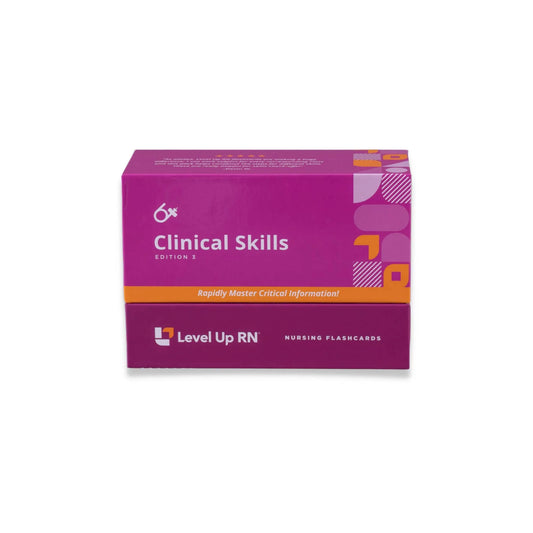Clinical Skills - Enteral Tube (G-Tube) Medication
A demonstration on how to administer medication through an enteral tube (e.g., NG, PEG, G-tube).
Full Transcript: Clinical Skills - Enteral Tube (G-Tube) Medication
Full Transcript: Clinical Skills - Enteral Tube (G-Tube) Medication
Hi. I'm Ellis with Level Up RN. In this video, I'll be demonstrating how to administer medications through a feeding tube. I'll be following the steps that we've included in our clinical skills deck. So if you have the deck, you can grab the card and follow along. If you don't have the deck and you're interested in checking them out, head on over to LevelUpRN.com.
If I need to give medications into a tube feeding, then ideally, I'm going to use liquid medications, right? But that's not always the case, and sometimes I'm going to need to dissolve a tablet into some water and introduce it into my tube. So before I enter anything into a tube, especially an NG tube, I want to check placement, and I can do that with a pH aspiration. I can check for bowel sounds, and just want to make sure that everything's going well with the tube itself. To prepare my tablets for crushing, I never use my enteric-coated tablets, of course, and I also can't use capsules. In a perfect NCLEX world if I have more than one type of medication, I'm going to need to crush and dissolve this one in its own cup, crush and dissolve this one in its own cup, etc. That may not be what you see in practice, but that is what is supposed to happen. So I'm going to go ahead and drop my tablet into my pill crusher and smash it down, which is probably one of my favorite things to do. Just very satisfying. So make sure that it gets into a nice, fine, powder material. So we can see that I've now got my crushed tablet. I'm going to add 15 or 30 milliliters of water. Nothing exact. Honestly, it's just enough to make sure that the tablet dissolves. And then with my piston syringe, I can go ahead and kind of stir it up and try to make sure that it dissolves more.
There are now two ways to have this be administered into my patient. I can do it via gravity, or I can do it via push. So I'm going to demonstrate both ways. So before I go ahead and enter medication into my patient, I always flush his tube. So I'm going to do that with gravity. I'm going to remove the plunger, pinch my tube off, insert my piston syringe, and pour some water in. Usually about 30 milliliters. And you'll see, I always hold it right here. I like to hold it where my thumb and forefinger are on the piston syringe and my other fingers are on the tube itself - here, I'll do it with my right hand so that you can see - because it just helps keep that intact because if, of course, the piston syringe slips out, I have now spilled-- hopefully, just water, but potentially, medication all over me, and then I don't know how much my patient has received. So if I'm going to do gravity, I can just pour the medication in via the syringe, and I'll follow it up with some water to flush, and I'll just allow that to flush through.
If I would like to do it via push, I'm going to use my piston syringe to draw up the medication from the cup. Now, this can be tricky. I didn't crush these exceedingly well, so it's going to be even trickier, but if you let it sit, then all of the sediment kind of settles onto the bottom. So you kind of have to get this "I wish I had four arms" moment of stirring while withdrawing on the plunger so that you get the medication into the water, and it doesn't all end up sitting at the bottom of your cup. So I think I did a fairly good job there for that not being really well crushed, and I'm going to, just like before, put a little pressure on the tube while it's open, insert my piston syringe, and then push this in. Now, the reason this isn't always best practice is no matter how much you tell yourself, or nurses know, don't just slam it. It's very compelling to slam it when I have 40 other things to do. So if you are administering it this way, please do not just slam it in there, right? That would be the equivalent of taking a shot. That's automatically introducing all of this directly into somebody's stomach. So try to slowly inject and introduce that medication so that you're not causing muscle cramping or spasms or honestly, just discomfort by too rapidly introducing it. And of course, like always, I'm going to follow up with some water so that I can flush my tube. We don't want to lose patency. We don't want a clog to occur. And I can slowly introduce that as well if I wanted to, or I could return to doing gravity. Once I'm done, I simply withdraw my piston syringe, pinch that, make sure that the cap gets nice and plugged back in, so I don't have any leakage in the bend, and that's how you administer medications through a tube.


